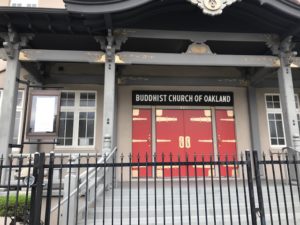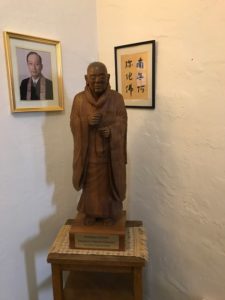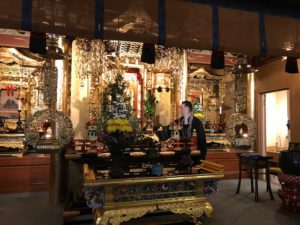I had a wonderful experience today. I attended the weekly family service the Buddhist Church of Oakland. The people were very warm and welcoming. A jolly fellow named Jon Takagaki—from the Board of Directors—showed me around, and sat next to me in the service… kindly showing me through their hymnal-style liturgies. The service is less than an hour long and geared to families with children.

Although the temple primarily caters to the Japanese-American community, the services were mainly in English. The organization is a branch of the Buddhist Churches of America, the American form of the Jodo Shinshu sect of Japanese Buddhism. I believe this is the second oldest Jodo Shinshu temple in America. The roots of the organization begin in 1901, and by the 20’s they had built this large and beautiful temple. In the fifties, the temple was physically divided in two and moved to its present location, due to interstate highway construction.
Amida Buddha and Shinran

Amida Buddha, known as Amitabha in Sanskrit, is an important figure in the broader Mahayana tradition of which all the northern traditions of Buddhism are a part, such as Tibetan, Japanese, and Chinese forms. The Jodo Shinshu tradition was founded by Shinran— a twelfth-century monk who disrobed. He taught that since Amitabha vowed to save all beings from suffering in samsara, the most appropriate practice for later times was to have faith and devotion to Amitabha, and recite his name as an expression of gratitude. Since it was not necessary to be a monk, this simple, joyful, practice thrived among lay people. Here is a statue of Shinran from the church lobby>>>
Inspirations

<<<This is a representation of Amida Buddha in his pure land. One of the senseis, priests, was cleaning before the service.
A bunch of things inspired me as a lay person who hosts Buddhist practices in my home:
- The value of having a super-friendly person to greet newcomers and accompany them throughout their first visit.
- It was great to have a designated time in the service when old-timers introduced new-comers and were welcomed by the sangha.
- Extremely simple, happy English sing-alongs with organ music were uplifting.
- This day a teen girl officiated at the service, and that was really cool.
- Like a church, there was coffee and pastries both before and after. You can’t go wrong with that.
- A sensei gave a short dharma teaching that focused on inclusion. As someone with different (empty) identities than the majority (white, lesbian), I felt I would not be rejected.
- The liturgies were upbeat, focusing on joy and gratitude. Who wouldn’t like that?




